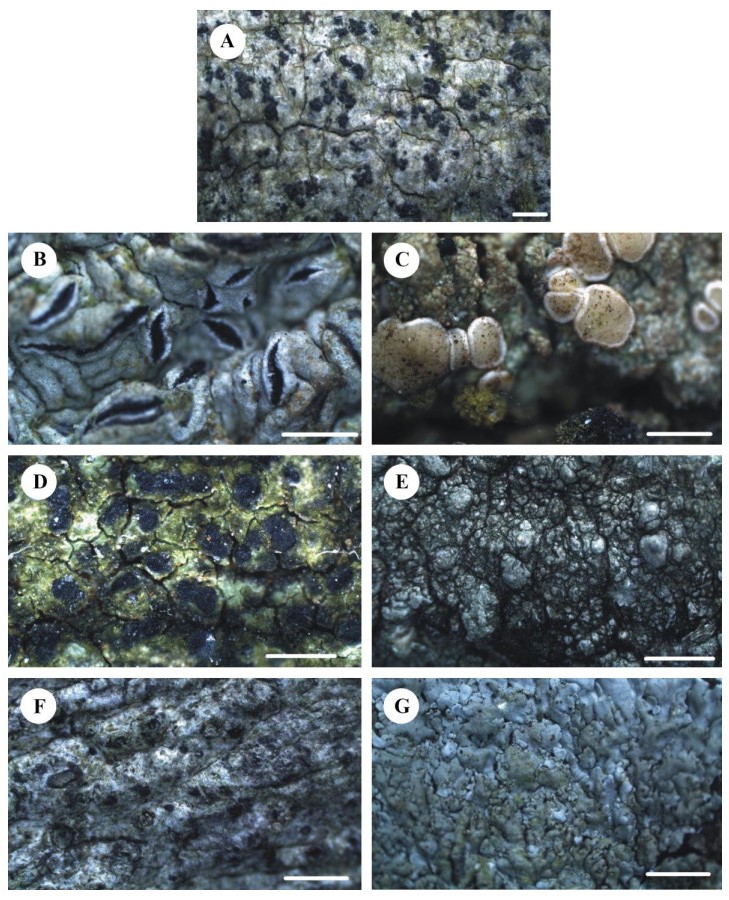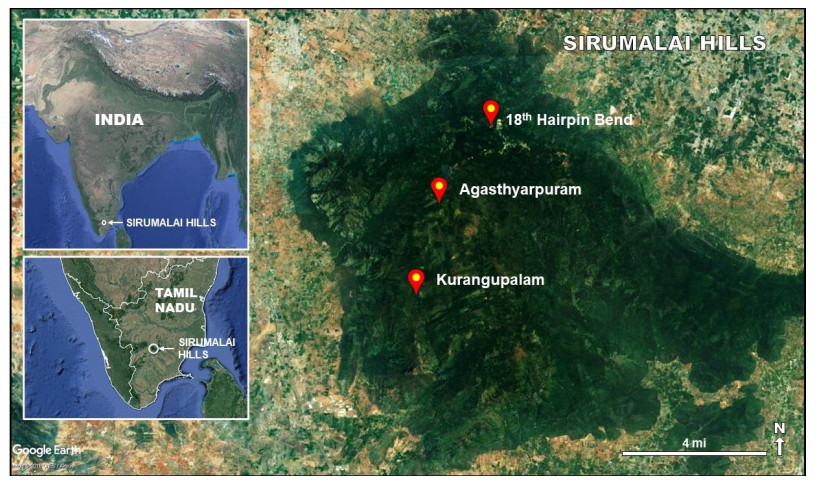HTML
-
India supports high lichen biodiversity, with 2714 recorded species. As new areas have been explored as well as revisionary studies in the recent years have resulted in a steep rise in novel species being discovered. During the years 2010 to 2017, a total of 411 species were added to the recorded Indian lichen biota (Sinha et al. 2018). However, many natural habitats of scientific interest remain to be explored. Although, the Eastern Ghats contribute significantly to the species richness and number of endemic lichen species, it has received less attention for conservation than the Western Ghats (Muthumperumal & Parthasarathy 2010). Nayaka et al. (2013) emphasized the current extent of lichen research in the Eastern Ghats. The lichen survey in Horsley and Tirumala Hills in Andhra Pradesh and Shevaroy Hills in Tamil Nadu resulted in several new additions to the recorded species of the Eastern Ghats (Nayaka et al. 2013). In our ongoing effort to explore new and under explored areas of the country, an attempt to examine the lichen diversity of Sirumalai hills in south India was carried out as a part of the "Workshop on lichen biology and bioprospecting (LBB 2017)".
The Sirumalai hills are situated in the southern part of Eastern Ghats in Dindigul district of Tamil Nadu (10°.07'-10°.18'N and 77°.55'-78°.12; E) (Fig. 1). The months March to July are the hottest in the hills and temperature range between 28 ℃ to 40 ℃. The temperature drops significantly during winter and range between 10 ℃ to 18 ℃. The months from February to August are mostly dry with occasional showers in April and May. There is a little rainfall in September, followed by the heavy showers of the north-eastern monsoon from the middle of October till the end of December. The average annual rainfall in the region is 120 to 132 cm, while the relative humidity varies from 30% to 80% (Karuppusamy 2007, Santharam et al. 2014). The area is characterized by disturbed scrub forests cover on lower hills, the dry deciduous forest at mid-elevation, and semi-evergreen forests at the higher elevation. The slopes of these hills can also be covered by savannah grassland. There have been frequent studies in this region on higher plants, including both medicinal and ethnobotanical plants. Sankar et al. (2009) reported a total of 85 plant species as new records for the Sirumalai hills, while Karuppusamy (2007) listed 90 species of medicinal plants used mainly by the 'Paliyan' tribes dwelling in the area. The altitudinal gradient, rich flora and fauna in the Sirumalai hills, indicates the possibilities of harbouring the luxuriant growth of lichens. Therefore, we surveyed this area to document its anticipated high lichen diversity.
-
A field survey was conducted during December 2017 in the Sirumlai hills and we collected about 200 lichen specimens from three localities viz., Agasthyarpuram (10°2'07.72"N; 77°7'63.02"E), Kurangupalam (10°8'56.31"N; 77°7'76.20"E) and near 18th Hairpin Bend (10°5'00.87"N; 77°9'67.25"E) (Fig. 1). The specimens were identified at CSIR-National Botanical Research Institute, Lucknow and deposited in herbarium LWG. The morphological details were examined using a stereo zoom Leica S8APO microscope. Anatomical details were studied using DM2500 optical microscopes attached with camera and image analysis software. Thin hand-cut sections of thalli and ascomata were mounted in either distilled water, KOH solution, or lactophenol cotton blue (LPCB). The amyloid reactions were tested using Lugol's iodine solution without or with pre-treatment with K. All measurements were made on material mounted in distilled water. Thallus chemistry was studied by spot tests and thin layer chromatography, which was performed in solvent system A and C following Orange et al. (2001). Awasthi(1991, 2007) and several other recent publications were consulted for lichen species identification (Harris 1995, Marbach 2000, McCarthy 2001, Kalb et al. 2004, Nayaka 2005, Coppins 2009, Ertz et al. 2009, Lücking 2009, Saag et al. 2009, Mishra et al. 2011, Aptroot 2012, Allen & Lendemer 2015, Aptroot & Lücking 2016, Joseph et al. 2018). Lücking et al. (2017) was followed for the classification of lichens while Jayasiri et al. (2015) was followed to obtain facesoffungi numbers.
-
Lichen specimens were identified as belonging to 95 species under 49 genera and 23 families (Table 1). The genus Japewiella is being reported for the first time from India which is represented by species J. tavaresiana (H. Magn.) Printzen. Further, six more species of lichens are also being reported for the first time for India viz., Arthonia atra (Pers.) A. Schneid., Graphis brevicarpa M. Nakan., Kashiw. & K.H. Moon, Micarea erratica (Körb.) Hertel, Rambold & Pietschm., Pertusaria cicatricosa var. deficiens A.W. Archer, Elix & Streimam, Porina subargillacea Müll Arg., and Pyxine schmidtii Vain.
Table 1. List of lichens recorded in the Sirumalai hills
Sl. No. Lichen taxa Family Growth Form Substratum Voucher number 1 *Alyxoria varia (Pers.) Ertz & Tehler Lecanographaceae CR Bark 17-030478 2 Allographa hossei (Vain.) Lücking & Kalb Graphidaceae CR Bark 17-031125B 3 *Anisomeridium biforme (Borrer) R.C. Harris Monoblastiaceae CR Bark 17-030479, 17-031125A 4 Anthracothecium macrosporum (Hepp) Müll. Arg. Pyrenulaceae CR Bark 17-030480 5 @Arthonia atra (Pers.) A. Schneid. Arthoniaceae CR Bark 17-030453 6 *A. redingeri Grube Arthoniaceae CR Bark 17-030481A 7 *A. subvelata Nyl. Arthoniaceae CR Bark 17-030482A 8 *Arthothelium nigrescens Makhija & Patw. Arthoniaceae CR Bark 17-030483C 9 Bacidia millegrana (Taylor) Zahlbr. Ramalinaceae CR Bark 17-030484 10 Bulbothrix isidiza (Nyl.) Hale Parmeliaceae FL Bark 17-030485A, 17-031140B 11 *B. setschwanensis (Zahlbr.) Hale Parmeliaceae FL Bark 17-030486A 12 Caloplaca bassiae (Ach.) Zahlbr. Teloschistaceae CR Bark 17-030487, 17-031150B 13 *C. herbidella (Arnold) H. Magn. Teloschistaceae CR Bark 17-030488 14 *Canomaculina subsumpta (Nyl.) Elix Parmeliaceae FL Bark 17-030489 15 Canoparmelia texana (Tuck.) Elix & Hale Parmeliaceae FL Bark 17-030490 16 *Chrysothrix chlorina (Ach.) J.R. Laundon Chrysotrichaceae LP Bark 17-030491 17 Cladonia cartilaginea Müll. Arg. Cladoniaceae FR Soil 17-030492 18 Coenogonium sp. Coenogoniaceae CR Bark 17-030493B 19 Cratiria lauri-cassiae (Fée) Marbach Caliciaceae CR Rock 17-030486C, 17-030495B 20 C. obscurior (Stirt.) Marbach & Kalb Caliciaceae CR Bark 17-030494B, 17-031158B 21 *Cryptothecia polymorpha Makhija & Patw. Arthoniaceae CR Bark 17-030495A 22 Diorygma hieroglyphicum (Pers.) Staiger & Kalb Graphidaceae CR Bark 17-030496 23 D. junghuhnii (Mont. & Bosch) Kalb Graphidaceae CR Bark 17-030483B 24 Dirinaria applanata (Fée) D.D. Awasthi Caliciaceae FL Bark 17-030485B 25 D. consimilis (Stirt.) D.D. Awasthi Caliciaceae FL Bark 17-030468C 26 Glyphis cicatricosa Ach. Graphidaceae CR Bark 17-030497A 27 *G. scyphulifera (Ach.) Staiger Graphidaceae CR Bark 17-030497B 28 Graphis ajarekarii Patw. & C.R. Kulk. Graphidaceae CR Bark 17-030469C, 17-0304671 29 *G. argentia Makhija & Adaw. Graphidaceae CR Bark 17-030498A 30 @G. brevicarpa M. Nakan., Kashiw. & K.H. Moon Graphidaceae CR Bark 17-030464 31 *G. chlorotica A. Massal. Graphidaceae CR Bark 17-030499 32 G. cincta (Pers.) Aptroot Graphidaceae CR Bark 17-030486B 33 G. duplicata Ach. Graphidaceae CR Bark 17-030477A, 17-030483A 34 *G. elegans (Borrer ex Sm.) Ach. Graphidaceae CR Bark 17-030476A 35 *G. furcate Fée Graphidaceae CR Bark 17-030500A 36 *G. handelii Zahlbr. Graphidaceae CR Bark 17-030481B 37 *G. polystriata Makhija, A. Dube, Adaw. & Chitale Graphidaceae CR Bark 17-031126 38 *G. pyrrhocheiloides Zahlbr. Graphidaceae CR Bark 17-030482B 39 *Hafellia demutans (Zahlbr.) Pusswald Caliciaceae CR Bark 17-031127A 40 Heterodermia diademata (Taylor) D.D. Awasthi Physciaceae FL Bark 17-030456B 41 H. dissecta (Kurok.) D.D. Awasthi Physciaceae FL Bark 17-031128 42 H. japonica (M. Sat? Swinscow & Krog Physciaceae FL Bark 17-031129A 43 H. obscurata (Nyl.) Trevis. Physciaceae FL Bark 17-031130 44 Hypotrachyna exsecta (Taylor) Hale Parmeliaceae FL Bark 17-031131 45 *H. neodissecta (Hale) Hale Parmeliaceae FL Bark 17-031132 46 @Japewiella tavaresiana (H. Magn.) Printzen Lecanoraceae CR Bark 17-030462 47 Lecanora albella (Pers.) Ach. Lecanoraceae CR Bark 17-031133B 48 L. chlarotera Nyl. Lecanoraceae CR Bark 17-030477B 49 L. helva Stizenb. Lecanoraceae CR Bark 17-030468B, 17-030482C 50 L. perplexa Brodo Lecanoraceae CR Bark 17-031134 51 Lepraria caesiella R.C. Harris Stereocaulaceae LP Bark 17-030463 52 L. caesioalba (B. de Lesd.) J.R. Laundon Stereocaulaceae LP Bark 17-030455 53 *L. coriensis (Hue) Sipjman Stereocaulaceae LP Rock & Soil 17-031135 54 *L. jackii Tønsberg Stereocaulaceae LP Bark 17-031136 55 Leptogium austroamericanum (Malme) C.W. Dodge Collemataceae FL Bark 17-031137 56 Lithothelium sp. Pyrenulaceae CR Bark 17-031138 57 @Micarea erratica (Körb.) Hertel, Rambold & Pietschm. Pilocarpaceae CR Rock 17-030460 58 Ochrolechia subpallescens Verseghy Ochrolechiaceae CR Bark 17-030466B 59 Parmelia erumpens Kurok. Parmeliaceae FL Bark 17-031139 60 Parmelinella wallichiana (Taylor) Elix & Hale Parmeliaceae FL Bark 17-030466A, 17-030474B 61 Parmotrema crinitum (Ach.) M. Choisy Parmeliaceae FL Bark 17-030473B, 17-030493A 62 *P. cristiferum (Taylor) Hale Parmeliaceae FL Bark 17-031140A 63 P. hababianum (Gyeln.) Hale Parmeliaceae FL Bark 17-031141 64 P. praesorediosum (Nyl.) Hale Parmeliaceae FL Bark 17-031142 65 P. reticulatum (Taylor) M. Choisy Parmeliaceae FL Bark 17-031143A 66 P. tinctorum (Despr. ex Nyl.) Hale Parmeliaceae FL Bark 17-030469D, 17-031144 67 @Pertusaria cicatricosa Müll. Arg. var. deficiens A.W. Archer, Elix & Streimam Pertusariaceae CR Bark 17-030451A, 17-030450B 68 P. cinchonae Müll. Arg. Pertusariaceae CR Bark 17-030476B 69 P. endoxantha Vain. Pertusariaceae CR Bark 17-030473A 70 *P. leucostoma (Ach.) A. Massal. Pertusariaceae CR Bark 17-030494C 71 P. splendens D.D. Awasthi & Preeti Srivast. Pertusariaceae CR Bark 17-031145A 72 *Phaeographis caesiodisca Staiger Graphidaceae CR Bark 17-030469B, 17-030473D 73 Phyllopsora furfuracea Zahlbr. Ramalinaceae SQ Bark 17-031146 74 *P. nemoralis Timdal & Krog Ramalinaceae SQ Bark 17-030495C 75 *Polymeridium refertum (Stirt.) Aptroot Trypetheliaceae CR Bark 17-031147 76 @Porina subargillacea Müll Arg. Porinaceae CR Bark 17-030458 77 Pyrenula adacta Fée Pyrenulaceae CR Bark 17-031148 78 P. astroidea (Fée) R.C. Harris Pyrenulaceae CR Bark 17-031149 79 Pyxine cocoes (Sw.) Nyl. Caliciaceae FL Bark 17-031150A 80 P. petricola Nyl. Caliciaceae FL Bark 17-031151 81 *P. philippina Vain. Caliciaceae FL Rock 17-031152 82 P. reticulata (Vain.) Vain. Caliciaceae FL Bark 17-031153 83 @P. schmidtii Vain. Caliciaceae FL Bark 17-030457A, 17-030475 84 P. subcinerea Stirt. Caliciaceae FL Bark 17-030451B, 17-030457B 85 Ramalina conduplicans Vain. Ramalinaceae FR Bark 17-030468A 86 R. pacifica Asahina Ramalinaceae FR Bark 17-031143B 87 R. subpusilla (Nyl.) Zahlbr. Ramalinaceae FR Bark 17-031127B 88 Remototrachyna flexilis (Kurok.) Divakar & A. Crespo Parmeliaceae FL Bark 17-031129A 89 Rinodina oxydata (A. Massal.) A. Massal. Physciaceae CR Rock 17-031154 90 Synarthonia inconspicua (Stirt.) Van den Broeck & Ertz Arthoniaceae CR Bark 17-030452 91 Tephromela atra (Huds.) Hafellner Tephromelataceae CR Bark 17-031155 92 Trypethelium eluteriae Spreng. Trypetheliaceae CR Bark 17-031156 93 Usnea aciculifera Vain. Parmeliaceae FR Bark 17-031157 94 Xanthoparmelia congensis (J. Steiner) Hale Parmeliaceae FL Rock 17-031158A 95 *Zwackhia viridis (Ach.) Poetsch & Schied. Lecanographaceae CR Bark 17-031159 * = new to Tamil Nadu, @ = new to India, CR = Crustose, FL = Foliose, FR = Fruticose, LP = Leprose, SQ = Squamulose The lichen biota of Sirumalai hills is dominated by crustose lichens (54 spp.) followed by foliose (28 spp.), leprose (5 spp.), fruticose (4 spp.) and squamulose (2 spp.) lichens. Similarly, most of the species were corticolous while Cratiria lauri-cassiae (Fée) Marbach, Micarea erratica (Körb.) Hertel, Rambold & Pietschm., Rinodina oxydata (A. Massal.) A. Massal. and Xanthoparmelia congensis (J. Steiner) Hale are found as saxicolous. Further, Lepraria coriensis (Hue) Sipman was found growing both on soil and rock. Cladonia cartilaginea Müll. Arg. was found exclusively on the soil. The family Parmeliaceae is the most diverse group in the Sirumalai hills with 17 species under eight genera. Graphidaceae is the most dominant family with 18 species under four genera. Among the various genera Graphis is the most dominant genus with 12 species followed by Parmotrema and Pyxine with six species each. The lichen community is also represented a good diversity of pyrenocarpous lichens represented by genera Anisomeridium, Anthracothecium, Lithothelium, Polymeridium, Porina, Pyrenula and Trypethelium. Although several specimens of Lithothelium were collected, we were unable to detect any ascospores. The most common lichens in the area are Dirinaria consimilis (Stirt.) D.D. Awasthi, Heterodermia dissecta (Taylor) D.D. Awasthi, Lecanora helva Stizenb. and Parmotrema tinctorum (Despr. ex Nyl.) Hale.
Previously the lichen biota of the state of Tamil Nadu comprised about 870 species. The present study has added seven new records for India, two new species for south India (Arthonia redingeri Grube and Lepraria caesiella R.C. Harris), and 29 species new to Tamil Nadu [marked as the asterisk (*) in Table 1].
-
Arthonia atra (Pers.) A. Schneid., Guide Study Lich.: 131. 1898 Fig. 2A

Figure 2. New records. A Arthonia atra. B Graphis brevicarpa. C Japewiella tavaresiana. D Micarea erratica. E Pertusaria cicatricosa var. deficiens. F Porina subargillacea. G Pyxine schmidtii. Scale bars: A = 2 mm, B, C, D, E = 1 mm, F, G = 2 mm.
Index Fungorum number: IF376348; Faces of fungi number: FoF09883
Thallus crustose, corticolous, whitish grey, ascomata lirellate, in groups, black, exciple carbonized, discontinuous at base, ascospores hyaline, transversely 3-septate, 18.0-25.2 × 4.1-4.5 μm.
Remarks - This is a cosmopolitan species found throughout Asia, Africa, Australia, Europe, Macaronesia, North and South America (Pentecost & James 2009). Previously this species was known as Opegrapha atra Pers., but recently Ertz et al. (2009) reinstated it as Arthonia atra.
Material examined - Nayaka et al. 17-030453 (LWG).
Graphis brevicarpa M. Nakan., Kashiw. & K.H. Moon, Bull. Nat. Sci. Mus., Tokyo, B 28(4): 107. 2002 Fig. 2B
Index Fungorum number: IF372560; Faces of fungi number: FoF09882
Thallus crustose, corticolous, smooth, whitish grey, apothecia lirellate, immersed, short, mostly unbranched, covered by thick thalline margin up to top, disc concealed, epruinose, exciple laterally carbonized, hymenium inspersed, ascospores transversely septate, 20.8-22.8 × 6.3-7.2 μm, and trace amount of norsticitic acid detected in TLC.
Remarks - Previously known from Oceania (Lücking 2009).
Material examined - Nayaka et al. 17-030464 (LWG).
Japewiella tavaresiana (H. Magn.) Printzen, Arnoldia 18: 4. 2000 Fig. 2C
Index Fungorum number: IF462818; Faces of fungi number: FoF09881
Thallus crustose, corticolous, verruculose, greenish to matt, apothecia round, slightly irregular in shape, 0.2-0.5 mm diam., disc yellowish to cream, margin paler than the disc, thin and persistent at maturity, exciple with radiating hyphae, ascospores hyaline, simple, 9.3-14.9?5.6- 6.2 μm, and atranorin (minor) detected in TLC.
Remarks - Earlier, this species was reported from Europe, Macaronesia (James 2009) and the Appalachian Mountains of Eastern North America (Allen & Lendermer 2015).
Material examined - Nayaka et al. 17-030462 (LWG).
Micarea erratica (Körb.) Hertel, Rambold & Pietschm., Biblioth. Lichenol. 34: 227. 1989 Fig. 2D
Index Fungorum number: IF125877; Faces of fungi number: FoF09880
Thallus crustose, saxicolous, smooth, areolate, greenish grey, apothecia small, up to 0.2 mm diam., round, disc and margin black, epithecium greenish, hymenium and hypothecium hyaline, ascospores haline, narrowly ellipsoid, up to 3 pesudoseptate, 5.8-10.3?3.6-4.2 μm, no lichen substances detected in TLC.
Remarks - This species was previously reported from England, Scotland, Ireland, Central Europe, North America, Australia and New Zealand (Coppins 2009). It also occurs on wood. Sirumalai hill specimen slightly differs in having hyaline hypothecium and pseudoseptate ascospores.
Material examined - Nayaka et al. 17-030460 (LWG).
Pertusaria cicatricosa var. deficiens A.W. Archer, Elix & Streimam, Mycotaxon 56: 389. 1995 Fig. 2E
Index Fungorum number: IF413724; Faces of fungi number: FoF09879
Thallus corticolous, crustose, greenish grey, cracked, verruculose, apothecia numerous, verruciform, tuberculate, irregular in outline, constricted at base, ostiole inconspicuous, ascospores 2 per ascus, hyaline, ellipsoidal, with prominent rough inner wall, 120.5-184.8 × 27.2-49.2 μm, stictic acid complex detected in TLC.
Remarks - Pertusaria cicatricosa var. deficiens differs from P. cicatricosa var. cicatricosa by lacking chlorinated lichexanthone. This species has previously only been reported from its type locality Papua New Guinea (Archer et al. 1995).
Material examined - Nayaka et al. 17-030451A (LWG).
Porina subargillacea Müll Arg., Bull. Herb. Boissier 1: 64. 1893 Fig. 2F
Index Fungorum number: IF402279; Faces of fungi number: FoF09878
Thallus corticolous, crustose, whitish grey, matt, ecorticate, perithecia emergent, black, 0.2- 0.4 mm diam., ostiole inconspicuous, ascospores colourless, transversely 7-septate, fusiform, 33.4- 40.8 × 2.1-2.5 μm, unidentified triterpenes at Rf class 6-7 detected in TLC.
Remarks - This species was reported from Australia and New Zealand (McCarthy 2001).
Material examined - Nayaka et al. 17-030458 (LWG).
Pyxine schmidtii Vain., Hedwigia 46: 170. 1907 Fig. 2G
Index Fungorum number: IF403619; Faces of fungi number: FoF09877
Thallus foliose, corticolous, whitish grey, up to 2.5 cm diam., adnate, lobes imbricate, plane to convex, upper surface pruinose towards lobe tips, pseudocyphellae rare, medulla white, lower surface black at centre, paler towards margin, rizhinate, apothecia absent, atranorin, zeorin, terpenes at Rf class 2 to 3 and at 3 are detected in TLC.
Remarks - Previously this species was reported from Australia, Asia and Papua New Guinea (Elix 2009).
Materials examined - Nayaka et al. 17-030457A, 17-030475 (LWG).
-
The authors are thankful to the Director of CSIR-NBRI for providing laboratory facilities and to the Principal of Kamaraj College of Engineering and Technology, Head of Biotechnology Department and members of the organizing committee for the LBB2017 workshop. One of the authors (SJ) is thankful to DST, New Delhi for the financial assistance under INSPIRE Faculty scheme (IFA18-LSPA 124). The authors are also grateful to Sirumalai Reserve Forest authorities for their permission to study the lichens of the area. (CSIR-NBRI manuscript numberCSIR-NBRI_MS/2019/12/04).
- Copyright: © 2021 by the author(s). This article is an open access article distributed under Creative Commons Attribution License (CC BY 4.0), visit https://creativecommons.org/licenses/by/4.0/.
| S Nayaka, S Joseph, SK Rajaram, S Natesan, K Sankar, MLR David, DK Upreti. 2021. Lichens of the Sirumalai hills, Eastern Ghats with one genus and six species new to India. Studies in Fungi 6(1):204-212 doi: 10.5943/sif/6/1/13 |













